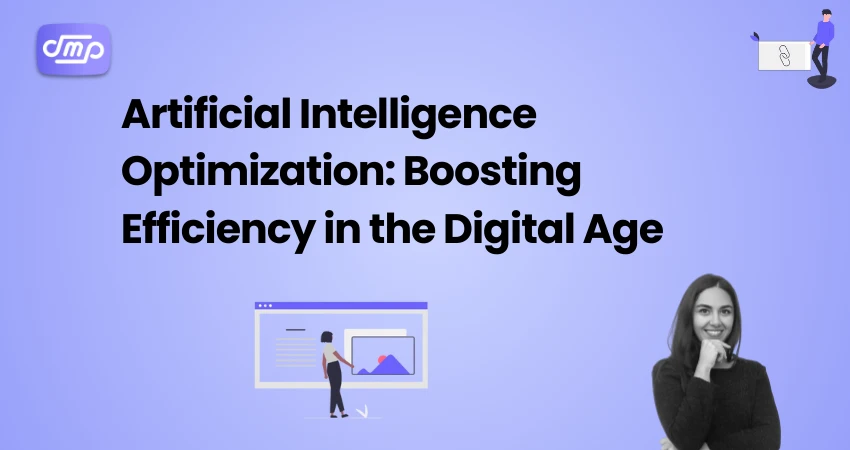
- August 26, 2025
- Digital Marketing, seo
- Digital Marketing
Table of Contents
Artificial Intelligence (AI) has emerged as the driving force behind innovation, enabling smarter solutions across industries. However, as AI systems become more complicated, it is critical to ensure they execute optimally. Here’s where Artificial Intelligence Optimization (AIO) comes into play. By refining algorithms, enhancing data quality, and optimizing processing resources, AIO enables businesses to achieve more accuracy, faster decision-making, and cost efficiency.
What is Artificial Intelligence Optimization?
Artificial intelligence optimization (AIO) is the process of improving AI systems’ efficiency, accuracy, and cost-effectiveness. While traditional AI focuses on building intelligent models capable of learning and making decisions, optimization ensures that these models perform to their full potential.
AI optimization entails fine-tuning every part of the AI lifecycle, including enhancing algorithms for quicker computation, cleaning and organizing data for greater accuracy, tweaking hyperparameters for peak model performance, and reducing resource usage without losing quality.
For example, in logistics, AI optimization can help to streamline delivery routes, saving fuel and time. In healthcare, it can improve diagnostic models, resulting in faster, more precise outcomes. Finally, AIO bridges the gap between raw AI capabilities and practical, real-world performance, enabling organizations to maximize the value of their AI investments.
Key Techniques in Artificial Intelligence Optimization
Optimizing AI entails a variety of techniques aimed at increasing accuracy, speed, and efficiency. The following are some of the most commonly utilized techniques:
- Algorithm optimization: Efficient algorithms are the core of AI optimization. Gradient descent advancements, evolutionary algorithms, and reinforcement learning advances enable models to train faster and provide more accurate predictions while incurring lower computational costs.
- Data Optimization: High-quality data is required for peak AI performance. This comprises data cleansing, feature engineering, dimensionality reduction, and dataset balance to ensure that the model learns from accurate and relevant information while minimizing errors and biases.
- Model Optimization: Model optimization aims to improve the AI model itself. To improve efficiency, common strategies include hyperparameter tuning (using grid search or Bayesian optimization), pruning (removing unneeded neural network connections), and quantization (lowering model size while maintaining accuracy).
- Resource Optimization: Artificial intelligence systems can be resource costly. Edge computing, cloud optimization, and hardware acceleration (via GPUs and TPUs) ensure that AI applications run quicker, spend less energy, and stay scalable in real-world scenarios.
- Automatic Optimization (AutoML): AutoML (Automated Machine Learning) automates model selection, feature engineering, and hyperparameter tweaking. This makes AI accessible to non-experts while still providing high-performance results with minimal manual intervention.
Benefits of Artificial Intelligence Optimization

Artificial Intelligence Optimization (AIO) provides considerable benefits for organizations and industries that implement AI solutions:
- Improved efficiency and speed: Optimized AI models analyze data faster, allowing for real-time decision-making. For example, efficient machine learning algorithms in financial trading can rapidly analyze market fluctuations, offering businesses a competitive advantage.
- Reduced operational costs: By optimizing algorithms and minimizing resource utilization, AIO reduces hardware, energy, and maintenance expenses, making AI deployments more affordable.
- Improved accuracy and performance: Improved data quality, fine-tuned models, and improved optimization approaches lead to higher prediction accuracy, which reduces errors in essential applications such as healthcare diagnostics and fraud detection.
- Improved Scalability: Optimized AI solutions are easier to scale across various devices, users, and locations while maintaining performance, assuring their effectiveness as businesses expand.
- Competitive advantage: Organizations that use AIO receive faster insights, more productivity, and better customer experiences, allowing them to stay competitive in an increasingly AI-driven market.
Challenges in Implementing AI Optimization
While Artificial Intelligence Optimization has enormous promise, firms frequently confront many challenges during implementation:
- High initial costs: Developing and deploying efficient AI systems necessitates significant investment in advanced technology, software tools, and qualified personnel, which can be a barrier for small and medium-sized organizations.
- Complexity of AI Models: Modern artificial intelligence models, particularly deep learning architectures, are sophisticated and resource hungry. Optimizing these models necessitates specific understanding in areas like as hyperparameter tweaking, algorithm refining, and neural network optimization.
- Data Privacy and Security Issues: AI optimization frequently requires enormous volumes of data. Ensuring compliance with data protection rules (such as GDPR) and keeping data confidentiality can be difficult.
- Lack of Skilled Talent: There is a global scarcity of AI and machine learning personnel that are skilled in optimization approaches, making it difficult for organizations to apply AIO successfully.
- Integration with legacy systems: Many firms struggle to combine efficient AI technologies with antiquated infrastructure, resulting in inefficiencies and increased implementation costs.
Artificial Intelligence Optimization in Action: Use Cases
Artificial Intelligence Optimization is altering industries by improving AI solutions’ performance in real-world circumstances. Here are a few significant examples:
- Healthcare: Improved picture recognition algorithms in optimized AI models allow for faster and more accurate disease identification, such as early cancer diagnosis. Resource optimization also allows for real-time patient monitoring via wearable devices.
- Finance: AI optimization enables high-frequency trading platforms, fraud detection systems, and credit risk assessments by processing enormous datasets in milliseconds, lowering errors and increasing profitability.
- Manufacturing: Optimized AI systems use predictive maintenance to evaluate machine data and detect issues before they occur, reducing downtime and increasing operational efficiency.
- Retail and E-Commerce: Optimized recommendation engines personalize e-commerce shopping experiences by evaluating user behavior in real time, which boosts consumer happiness and sales conversions.
- Logistics and Supply Chain: AI-powered route optimization enables logistics organizations to save fuel, enhance delivery times, and handle interruptions more effectively.
Future of Artificial Intelligence Optimization
The future of Artificial Intelligence Optimization is set to transform how businesses use AI to drive development and innovation. Key trends influencing the future include:
- AutoML and No-Code AI: Automated Machine Learning (AutoML) and no-code platforms will make AI optimization available to non-technical consumers, minimizing the need for specialized talent.
- Explanatory AI (XAI): As AI models become more transparent and interpretable, optimization will prioritize not only accuracy, but also trust and compliance in crucial applications such as healthcare and finance.
- Federated Learning: Optimizing AI across decentralized data sources while maintaining privacy will be an important trend, particularly in businesses with strong data restrictions.
- Integration of Emerging Technologies: AI optimization will be combined with IoT, robots, and Web3 technologies to create smarter, autonomous systems that can self-improve and adapt.
- Sustainability-Focused AI Optimization: With growing worry about energy usage, future optimization strategies will prioritize eco-friendly AI solutions, lowering carbon footprints while maintaining high performance.
Businesses that implement these AI optimization technologies will gain a huge competitive advantage in the next years by providing faster, smarter, and more sustainable solutions.
Conclusion
Artificial Intelligence Optimization is no longer a luxury; it is a must-have for firms looking to succeed in the digital age. Organizations may realize AI’s full potential by increasing algorithms, data quality, and employing sophisticated methodologies. AIO is altering industries around the world, from increasing shipping efficiency to enabling life-saving healthcare advances.
As AI technologies advance, firms that embrace optimization will remain ahead of the curve, producing faster outcomes, lowering costs, and attaining long-term success. The future belongs to those who not only use AI, but also optimize it for maximum impact.











